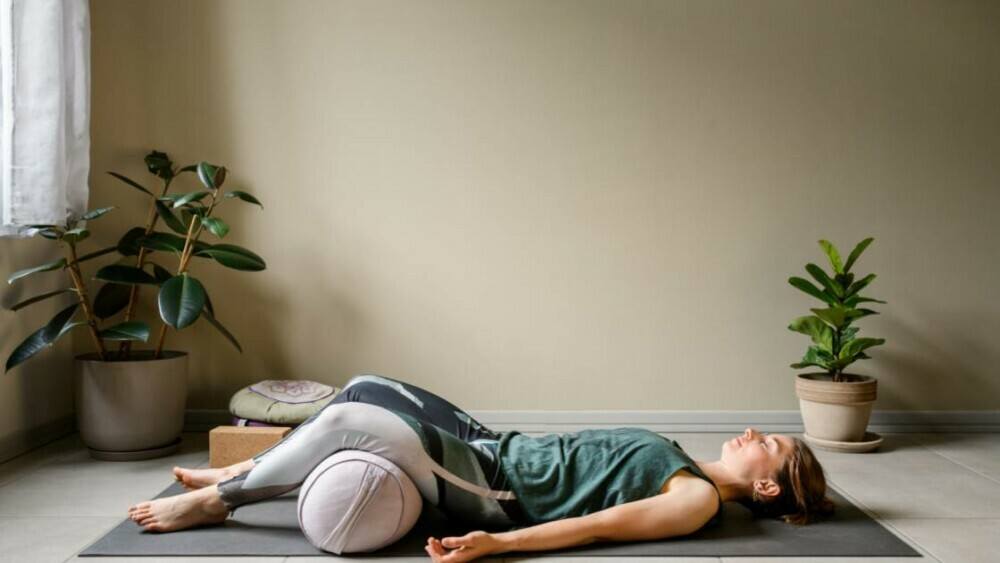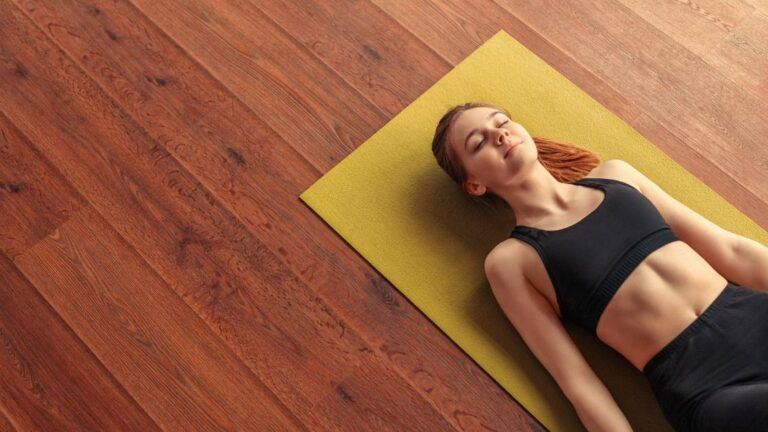In today’s busy world, finding time for meditation might seem impossible. But what if I told you that you can meditate while lying down? Yes, it’s true! In this post, we’ll explore how to meditate lying down. We’ll talk about the techniques, benefits, and tips to help you relax and be mindful while lying comfortably. Whether you have physical limitations, back pain, or just want a new way to relax, lying down meditation can help you find peace and calmness. So, let’s start by addressing the below question on your mind.
Can You Meditate While Lying Down?
Some might raise an eyebrow at the idea of meditating while lying down. Isn’t meditation usually done sitting cross-legged on a cushion? While the traditional way is well-known, lying-down meditation is also a valid and effective method. It’s okay to have doubts, but lying down meditation can be just as helpful and transformative as the seated kind.
How is it Different from Sitting Meditation?
- The main difference between lying down and sitting meditation is how you position your body. Sitting meditation wants you to be upright and alert, while lying-down meditation focuses on comfort and relaxation.
- This small change can make a big difference in how you feel during meditation. Lying down might be especially good if you have physical discomfort or trouble moving because it takes the pressure off your spine and joints.
- Also, lying down can help you relax your body more deeply and think more clearly. But remember, lying down meditation has its challenges, like the temptation to fall asleep or lose focus.
- Even though they’re different, both types of meditation aim to help you be more mindful, present, and peaceful.
Posture Tips While Meditating Lying Down

When you’re doing lying down meditation, getting your posture right is important for feeling comfy and focused. Here are some tips to help you find a relaxed and supportive position:
How to Keep Your Spine Straight and Energized?
- Start by lying on your back with your spine in a natural position. Let your body sink into the surface beneath you, but keep your spine feeling long.
- Imagine a straight line from the bottom of your spine to the top of your head, giving space between each bone. This helps energy flow smoothly through your body, making you feel more alive and open.
Where to Place Your Hands?
- Try out different hand positions to see what feels best and grounding for you.
- You might like resting your hands gently on your belly, feeling your breath go in and out. Or you could let your arms relax by your sides with your palms facing up, making you feel more open and receptive.
- Another option is to place your hands over your heart, connecting with your deepest feelings and intentions. The goal is to find a position that helps you relax and be mindful.
How to Position Your Legs to Ease Lower Back Pressure?
- To take pressure off your lower back, try bending your knees and putting your feet flat on the surface. This supports the natural curve of your spine, stopping any strain or discomfort.
- You can also try putting a cushion or rolled-up blanket under your knees for extra support and comfort. Find a leg position that feels comfy and stays that way for your whole meditation.
Why Stillness Matters & How to Adjust Gently?
- Once you’re comfy, try to stay as still as possible during your meditation. Being still helps you feel calm inside and be more present in your meditation.
- But if you start feeling uncomfortable or restless, it’s okay to adjust your position.
- Do it slowly and mindfully, without suddenly moving around. Just make small changes to make yourself more comfy and focused.
By paying attention to your posture and making small adjustments when needed, you can make lying down meditation feel supportive and nourishing. Listen to your body and give it what it needs, so you can have a peaceful and refreshing meditation time.
Breathing: The Heart of Meditation

Breathing is super important in meditation. It helps you stay focused and calm. Here’s how to use your breath to make your meditation better:
Understanding the Role of Breath
- Your breath connects your body and mind. When you pay attention to your breath during meditation, it helps you feel calm and present. It’s like a guide, bringing you back to the moment and away from worries.
- Your breath also shows how you’re feeling inside – if you’re stressed or relaxed. By breathing mindfully, you can relax your body and mind, and feel more peaceful.
How to Breathe Deeply
- Deep breathing is a big part of meditation. It helps your body relax naturally. Start by putting one hand on your belly and the other on your chest. Breathe in deeply, feeling your belly push out against your hand.
- Let your breath fill up your chest too. Breathe out slowly, feeling your belly go back in. Keep doing this, focusing on how your breath feels. Each breath should help you relax more.
Counting Your Breaths or Just Going with the Flow
- In meditation, you can count your breaths to stay focused. Start from one and count up to ten, then start over.
- This helps keep your mind from wandering. Or you can just watch your breath without counting.
- Let it flow naturally, without trying to change it. Pay attention to how it feels. The important thing is to stay aware and calm.
Using Mantras or Positive Words
- Mantras or positive words can make your meditation even better. Pick a word or phrase that feels right to you, like “peace” or “I am calm.”
- Repeat it silently with each breath. Let the words sink in and keep you focused on the present moment.
By guiding your breath in meditation, you can make your practice stronger and feel more connected to yourself and the world around you.
Managing Thoughts & Feelings While Lying Down

When you’re doing lying down meditation, you might notice thoughts and feelings popping up. Here’s how to deal with them calmly and mindfully:
Accepting & Watching Thoughts Without Judging
- It’s normal for thoughts to show up during meditation. Instead of trying to stop them, just watch them without judging. Imagine you’re like a person watching clouds in the sky – just observing without getting caught up in the story.
- Notice your thoughts without giving them too much importance. By doing this, you create space for clear thinking and understanding.
Using Visualizations for Peace
- Visualizations can help you feel more peaceful during lying-down meditation. When thoughts or feelings come up, imagine them as leaves floating on a gentle stream or clouds moving in the sky.
- Picture yourself surrounded by a warm light or in a calm place like a forest or beach. These visualizations can help you feel calm and relaxed, quieting your mind.
Dealing with Distractions by Focusing on Breath or Words
- Distractions happen to everyone during meditation, but they don’t have to ruin your practice. When you notice your mind wandering, gently bring your focus back to your breath or a word you repeat silently.
- Pay attention to the rhythm of your breathing or repeat the word with each breath. This helps bring your focus back to the present moment.
Letting Feelings Come & Go
- Emotions are a natural part of life, and they might come up during lying-down meditation. Instead of pushing them away, let them be there without holding onto them.
- Notice how they feel in your body, like a tightness in your chest or a knot in your stomach. Breathe into these feelings with kindness, and they’ll start to fade away on their own.
- Remember, emotions come and go, just like waves in the ocean. Letting them be can help you feel stronger and more peaceful inside.
By dealing with thoughts and feelings calmly and kindly, you can make your lying-down meditation even better.
Dealing with Challenges & Distractions
Even if you’ve been doing meditation for a while, you might still face challenges and distractions. Here’s how to handle them and stay focused during lying-down meditation:
Strategies for Beating Restlessness & Sleepiness
- Feeling restless or sleepy is normal during meditation too. To calm restlessness, try moving gently or stretching to release tension. You can also imagine yourself rooted to the ground like a tree to help you feel more grounded.
- If you’re feeling sleepy, try meditating at a different time when you’re more awake. You can also sit up a bit or open your eyes slightly to help you stay alert.
Addressing Common Problems
- Sometimes during lying down meditation, you might feel uncomfortable, have too many thoughts, or find it hard to concentrate. It’s okay – these things happen to everyone. Instead of getting frustrated, accept them as part of the meditation process.
- Remember, they’re chances for you to learn and grow. Then, gently bring your attention back to your breath or whatever you’re focusing on. Be patient with yourself and take your time.
Cultivating Patience & Kindness
- Patience and kindness are important qualities to have during lying down meditation. Instead of being hard on yourself for not being perfect, be gentle and understanding.
- Remember, meditation is a journey, not a race. Each moment you spend meditating is a chance to learn and grow. Celebrate the small victories and moments of calm, and be kind to yourself when things get tough. Meditation is all about taking care of yourself and being kind to yourself.
By using these strategies and being patient and kind to yourself, you can handle challenges and distractions during lying-down meditation.
Exploring Yoga Nidra: The Ultimate Lying Meditation
Out of all the different ways people meditate lying down, Yoga Nidra stands out as a really helpful and easy form of lying down meditation. It comes from ancient yoga practices and is often called “yogic sleep.” It’s all about relaxing deeply and thinking about yourself while lying comfortably.
What’s Special About Yoga Nidra
Yoga Nidra is like taking a guided trip to a relaxation town. It helps you feel super calm and aware without needing to concentrate hard like in other meditations. You simply relax and let your body and mind chill out completely.
Why Yoga Nidra is Great For You
- Bye-bye Stress: It helps you relax your body and mind, making stress and tension disappear, and leaving you feeling calm.
- Sweet Dreams: Doing Yoga Nidra regularly can help you sleep better, giving you deeper and more refreshing sleep.
- Healing Inside: By getting super relaxed and thinking about yourself deeply, Yoga Nidra can help you heal emotionally and understand yourself better.
- Mind Power Up: It makes you more aware of your body, thoughts, and feelings, so you can handle life with more clarity and focus.
How To Do Yoga Nidra
Find a comfy spot to lie down in a quiet place. You can use a yoga mat, bed, or soft carpet. Then, follow along with a guided Yoga Nidra session. It usually includes relaxing your body step by step, paying attention to your breathing, imagining things, and saying positive things to yourself.
Want to try out Yoga Nidra & see how it can change your life? Dive into my detailed review of Richard Miller’s Yoga Nidra Meditation course. Gain access to guided sessions designed to help you unlock the full potential of this practice. Whether you’re new to Yoga Nidra or seeking to deepen your understanding, discover how this program can empower you on your journey to a balanced, fulfilling life. Explore now and unlock the transformative potential of Yoga Nidra!

Power of Yogic Sleep?
Discover the transformative power of iRest Yoga Nidra with Dr. Richard Miller’s immersive program. Unlock vibrant health, inner healing, and personal empowerment today.

